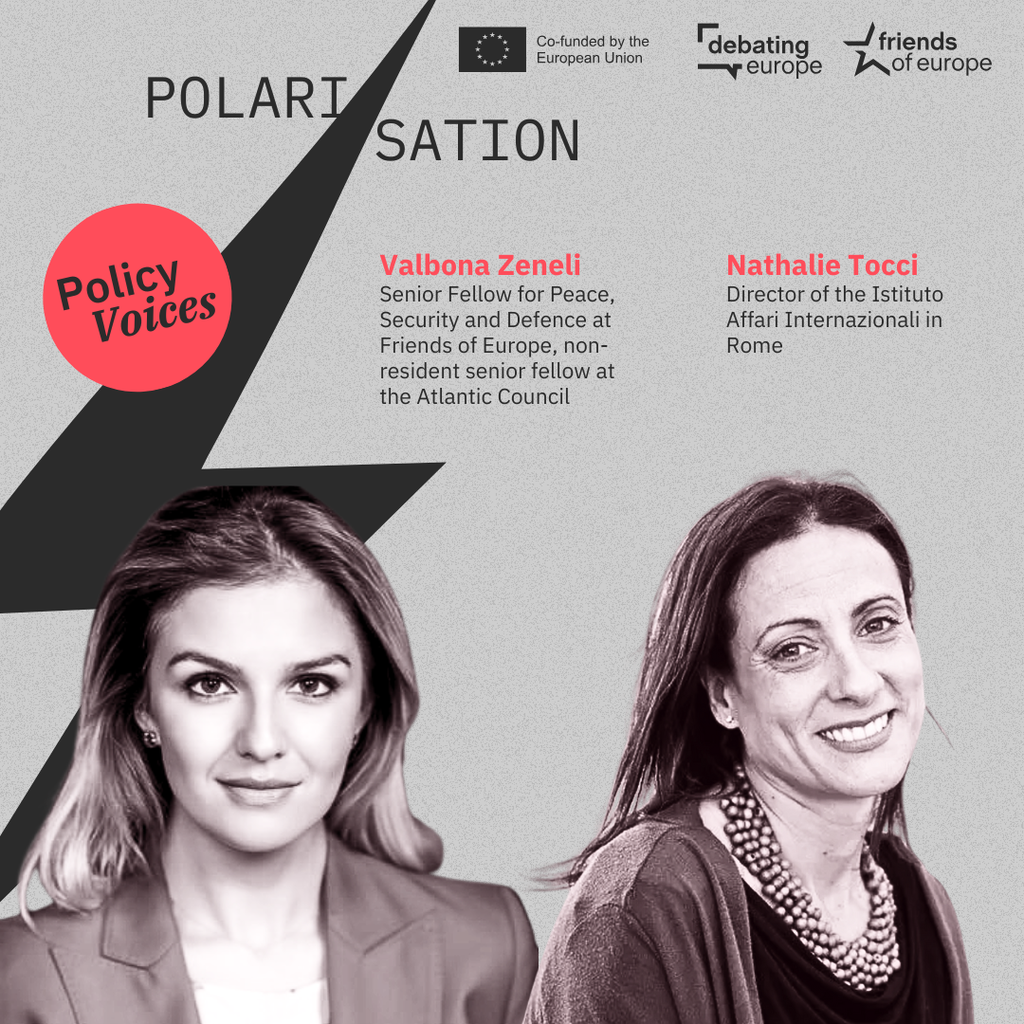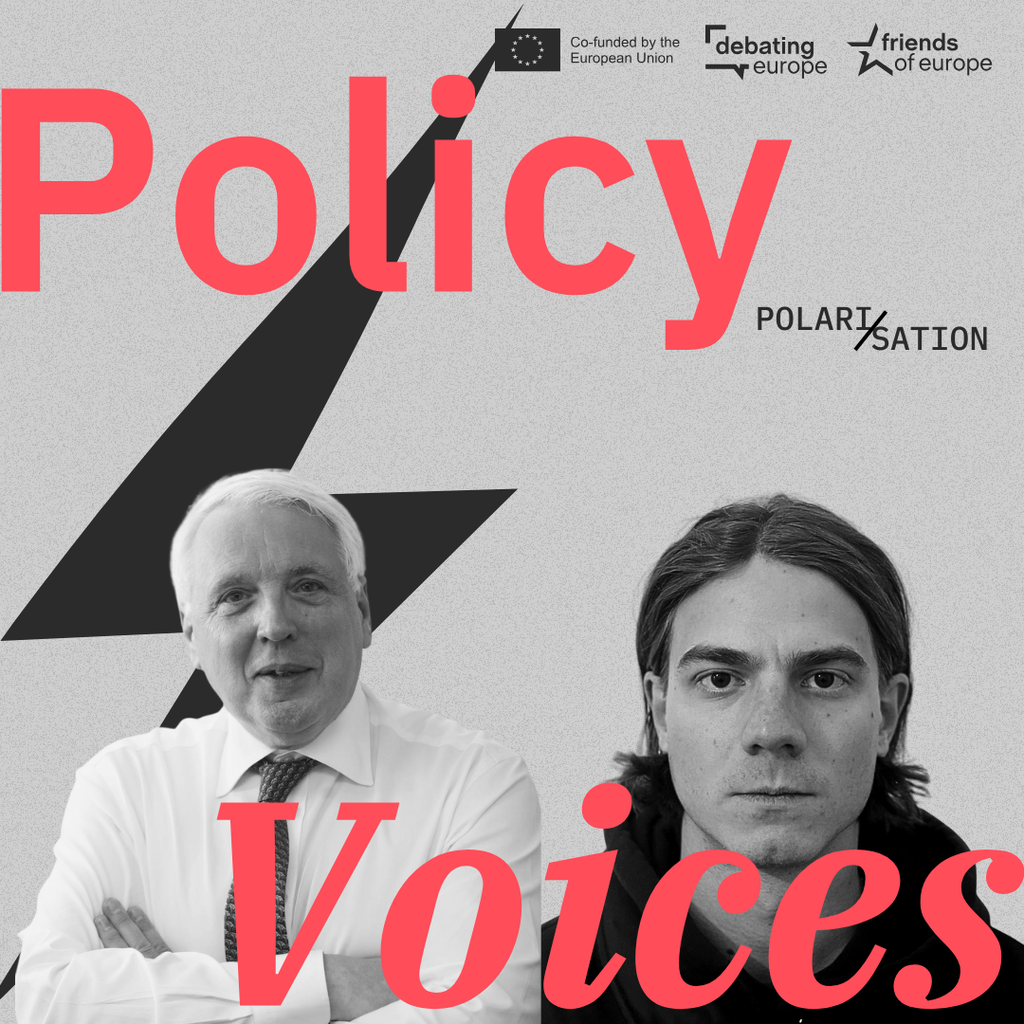From ambition to action: building Europe’s Defence Union
Past event In person

- Area of Expertise
- Peace, Security & Defence
Peace, Security & Defence

Senior Fellow for Peace, Security and Defence at Friends of Europe, and former Deputy Assistant Secretary General for Emerging Security Challenges at the North Atlantic Treaty Organization (NATO)
In the winter of 2010, I moved to a new division at NATO headquarters in Brussels called “Emerging Security Challenges”. As part of my new portfolio I had to deal with the alliance’s energy security. This issue had shot to the top of the political agenda after Russia cut off its gas supplies to Europe following a dispute with Ukraine over the latter’s arrears to Moscow. In the Baltic states, Bulgaria and Romania, apartment dwellers suddenly found their gas cookers, hot showers and radiators out of action as outside temperatures dropped below zero.
Back at NATO HQ we worried that Russia could use its gas exports to undermine Ukraine’s economy and to hold Europe to ransom by reducing or withholding natural gas exports. We set up an Energy Security Centre of Excellence in Riga to study our vulnerabilities to supply shocks and to propose solutions.
Yet just as quickly as the energy security issue flared, it subsided. Russia and Ukraine came to an agreement (heavily promoted by the EU), in which Russia made good on its gas transit payments to Kiev for its use of the Ukrainian pipeline into eastern Europe, and Ukraine showed good faith by paying its outstanding debts to Moscow for the delivery of this gas. Europe needed to buy Russian gas, but Russia also needed to sell that gas given the preponderance of fossil fuels in its export earnings. Moscow recognised only too well that too many gas supply disruptions would damage its reputation as a reliable supplier and only accelerate Europe’s search for alternative sources of gas supplies.
At the same time, the Russian-Ukrainian gas dispute spurred the European Union to improve the continent’s energy diversification and security. The Commission’s third energy package increased gas storage requirements, built pipeline interconnectors and reverse flow capabilities across EU borders, and required gas suppliers like the Russian Gazprom to ‘unbundle’ (or divest) their holdings of pipeline infrastructure and energy terminals. This was intended to allow more companies into the market and to prevent any one player from acquiring a monopoly position.
The average basket of coal, gas and oil has risen by 95% since May
Moreover, the Commission advocated more efficient use of energy and the faster and broader introduction of renewable fuels from wind, solar, biomass and hydrogen. Some European countries, like Lithuania and Poland, built liquefied natural gas (LNG) terminals to be able to import gas from across the world, particularly once the United States Congress lifted restrictions on its LNG exports.
All these measures quickly took energy security back off the NATO agenda as gas prices fell and the European energy mix improved. The COVID-19 pandemic then came along to depress economic activity, and halt supply chains and travel. At one stage, as Russia and Saudi Arabia failed to agree on oil output reductions, the price of crude actually fell to zero with the result that oil producers were paying the oil companies to come and collect it. Political scientists began to write articles prophesising doom and gloom for Russia and other authoritarian fossil fuel exporters who would not be able to transition to the new green and clean energy economy fast enough.
Yet if a week is a long time in politics, then a year is an eternity when it comes to energy security. Now the average basket of coal, gas and oil has risen by 95% since May. US motorists are paying $3 for a gallon at the gasoline pump. The United Kingdom has just turned some coal-fired power stations back on as gas prices soar and many small gas suppliers have gone bust, leading commentators to warn of a ‘winter of discontent’. In both China and India, power outages have affected whole provinces, wiping out power for millions at a time. Coming so soon after one of the hottest summers on record, the sudden prospect of spiralling energy bills, supply chain disruptions, sharply increasing inflation and power cuts has come as a shock. So what has happened?
First and foremost, the global economy has bounced back from COVID-19 faster than many predicted. This has put Europe into competition with Asia for spare energy capacity, particularly when it comes to LNG exports where prices in Asia are traditionally higher than in Europe. There is currently a 14% shortfall between LNG supply and demand. In Europe many investors had stopped backing new ventures in gas, oil or coal production at home, such as fracking, as they saw a declining market undercut by growing taxation of fossil fuels and tighter national or EU regulation and standards. Germany had decided to halt nuclear power generation. In a market where renewables are only penetrating slowly, and traditional fossil fuels may need to be regenerated at short notice to overcome supply and price bottlenecks, this gives an advantage to authoritarian states like Russia that are willing and able to produce fossil fuels with minimal fiscal or environmental constraints.
Short-term measures need to go hand-in-hand with longer-term steps to strengthen Europe’s energy security and resilience
Fossil fuels currently satisfy 86% of primary energy demand. Last week the International Energy Agency, based in Paris, reported that global investment in renewables is running at less than 50% of the required level to fulfil the energy needs of a net-zero carbon economy by the year 2050, the target set by the G7 and the bulk of the industrialised economies. That means doubling investment levels from $2tn to between $4tn and $5tn. The energy transition may be inescapable but it will not be cheap. The Financial Times recently calculated that insulating all the 28mn homes in the UK would cost £525bn up to 2040, and when the UK government announced this week that it would halt the installation of new gas boilers in 2035 in favour of cleaner power pumps, it was obliged to offer households a £5,000 subsidy to help offset the major investments required.
Yet the current energy crisis has a number of more immediate causes. One is the rundown of storage facilities, leading to tighter energy markets, after a hot summer when air conditioning units in the US, Canada and southern Europe have been switched on around the clock. Oil inventories are at 94% of their usual level, European gas storage is at 84%, and coal reserves in India and China have dipped below 50% of their usual level. The long COVID-19 shutdown has delayed vital maintenance work on a number of pipelines, generators and switching stations. A cross-Channel link, which enabled France to send electricity to the UK, was put out of action by a fire. Having invested heavily in wind farms in the North and Baltic seas, as well as onshore, Europe experienced a wind-free summer, and sunshine was largely absent from northern Europe during July and August too, leading to a sharp drop in wind and solar power generation from these normally reliable sources. Floods in Asia impeded coal extraction and deliveries. Drought in Latin America shut down hydroelectric power generation.
Climate change and the frequency of extreme weather events, always the key driver of the urgency of the energy transition, can paradoxically hold it up by exacerbating energy shortages and the need to resort to fossil fuels in the short term. If the soaring prices of gas and petrol are blamed on the energy transition and the green economy, there is a danger that this necessary but painful step will be increasingly rejected by hard pressed and poorer consumers.
So how can Europe manage the current energy crisis in a way that avoids its early return? As usual in these situations, short-term measures need to go hand-in-hand with longer-term steps to strengthen Europe’s energy security and resilience.
The EU should be wary of increasing its energy dependency on Russia
Current gas price hikes are setting the scene for a perfect storm. Popular discontent fuelled by inflation, the withdrawal of COVID-related employment support, and supply chain bottlenecks and labour shortages in distribution networks are reminders of governments’ need to endure adequate gas supplies through the winter, especially if it becomes a cold and lengthy one. The European Commission has led the way by proposing a package of measures that will be discussed by EU leaders at their summit this week. They include the reduction of VAT on gas bills, the temporary suspension of the EEG energy conversion surcharge in Germany that adds 20% to domestic household energy bills, the reduction in production taxes levied on industry, and special fuel vouchers for the 3mn EU citizens on the poverty line, as calculated by the European Trade Union Confederation. Other steps include capping the gas price and using the receipts from the EU carbon emissions trading scheme (ETS) and carbon border adjustment levies to finance faster renewable fuel production and storage and distribution grids. One interesting idea is to use financial headroom in the European Investment Bank to generate more capital for investment in renewable projects, such as hydrogen or longer life batteries.
In the short term, some European governments may be receptive to the siren calls of Vladimir Putin. The Russian leader has predictably blamed the continent’s gas problems on the EU’s delays in certifying the Nord Stream 2 pipeline whose construction was completed in September. Nord Stream 2, like its counterpart Nord Stream 1, can pump 55bcm of gas from Siberia to Germany every year, an amount that would considerably ease Europe’s current gas shortage, even if it will take some time to reach this maximum capacity.
Putin has rebuffed accusations from some European energy experts that Russia is holding back on its gas supplies to Europe to put pressure on the EU to speed up the certification of Nord Stream 2. Yet the Russian leader’s arguments are disingenuous. Ukraine has a contract with Russia to receive 109mcm of gas each day, some of which could be pumped on to the EU. Yet Gazprom is only supplying 85mcm a day, meaning that the Ukrainian transit route which could be activated immediately is being underutilised.
This said, the EU should be wary of increasing its energy dependency on Russia, particularly at a time when it is ramping up military pressure on many EU member states and trying to undermine EU democracies through a multitude of hybrid warfare tactics. Russia already accounts for 41% of the EU’s gas supplies and the figure will rise close to 50% once Nord Stream 2 starts to operate. In the oil sector, Russia and OPEC combined account for around 50%. Having begun a policy of energy diversification a decade ago, the EU needs to pursue it to resist falling back on Russia or the Gulf petro-monarchies, even as a short-term option. The EU needs a serious and realistic energy security policy. What would this look like?
Currently only 4% of electricity is traded across international borders compared to 24% for gas and 46% for oil
In the first place, gas will be indispensable as a bridging solution in a transition to renewables which will inevitably take some decades, particularly in the transport sector. Gas has only half of the polluting effect of coal and oil, and can be used now, whereas it will be a considerable time until wind and solar capacities reach sufficient mass to meet demand. So the EU needs to exploit other gas sources. One option would be to work with Turkmenistan to build a trans-Caspian pipeline bypassing Russia via Georgia and the Caucasus. Another would be to work with Greece, Cyprus, Egypt and Israel to exploit the considerable gas deposits in the Eastern Mediterranean. Explorations continue off the coast of Cyprus. This week Greece and Egypt signed an agreement in Athens to build a connector between the two countries to deliver Egyptian gas and solar electricity to Greece.
Of course, the full exploitation of the Eastern Mediterranean reserves depends on a relaxation of current military tensions with Turkey, admittedly no easy matter in the current strategic environment and with Turkey’s EU application at a standstill. Yet it is a challenge that the new geopolitical EU needs to meet through some form of resource-sharing arrangement and maritime exploration zones with Ankara. Building more terminal capacity to receive and de-liquify LNG within the EU would also broaden the scope of the EU’s energy security network and bolster against future shocks.
Secondly, the ongoing need for gas makes it more important that the EU invests in carbon capture and storage technologies to reduce the environmental impact. Here a comprehensive regime for the pricing of carbon is a necessity. Only 20% of fossil fuel emissions globally are currently subject to a carbon tax. Getting this right is key to generate the investments needed not only for clean energy but also to remove carbon from the atmosphere that will inevitably accrue from more use of gas up to mid-century, as well as to plant more forested areas as carbon sinks.
Thirdly, the creation of a cross-border single electricity market is critical. Currently only 4% of electricity is traded across international borders compared to 24% for gas and 46% for oil. So the EU needs to Europeanise the internal electricity market to switch supply rapidly from one region of the Union to another. This will require cables and interconnectors, as well as the capacity to convert clean energy into hydrogen for transportation across the continent.
It is not easy to make the case for nuclear power in Europe especially after the nuclear reactor disasters at Three Mile Island, Chernobyl and Fukushima
Finally, nuclear power has its role to play too. Due to its major development and life cycle costs, nuclear power is expensive and cannot be more than 10% to 15% of the overall EU energy market share. Yet it provides a useful buffer against gas monopolies and it is permanently available even when there is no wind or sun. Moreover, nuclear power does not pollute or add to global warning. Of course, it is not easy to make the case for nuclear power in Europe especially after the nuclear reactor disasters at Three Mile Island, Chernobyl and Fukushima.
Yet as the price of gas soars, the differential with the cost of generating a kilowatt of electricity from gas or coal narrows, and the risks associated with nuclear reactors have to be compared with the certain consequences of burning more fossil fuels up to mid-century. Especially when we consider that during the last two years more fossil fuels have been consumed than in any previous year, and not withstanding all our current focus on combating climate change and accelerating the energy transition. Moreover, the nuclear industry has worked hard to improve security by building smaller reactors and governments are mindful to locate nuclear plants away from coastal areas or earthquake zones. So unsurprisingly some European countries, like the UK, are taking a second look at nuclear power and building a new generation of power stations, albeit in the British case with increased reluctance to accept Chinese financing.
Some countries will use the current energy crisis as an excuse to cling to fossil fuels and postpone the energy transition. When the Chinese Premier, Li Keqiang, speaks of “a sound and well-paced” transition, we know that this is an euphemism for continuing to burn coal. Yet going backwards is in no one’s long-term interest. The energy crisis is all the more reason to accelerate a move to renewables over which EU countries will have far more control than they do over fossil fuel supplies brought in over great distances, and often from authoritarian states that use oil and gas revenues to maintain repressive regimes.
Nonetheless the current gas price hikes are a reminder that at the forthcoming COP26 in Glasgow it will not be enough only to pledge to reach more ambitious targets for greenhouse gas emissions up to mid-century and to achieve carbon neutrality by that timeline. We also need a transition plan and a progressive conversion strategy from gas to clean energy in order to get there. Going too slowly risks burning more massive amounts of carbon beyond the 1.5°C target for global warming over pre-industrial levels. The damage to the environment could be irreversible. Yet going too quickly and before renewables are fully mature and available in mass volumes risks undermining living standards, damaging economic stability and provoking a popular backlash. The challenge for the wise EU policymaker is to navigate a safe course between the Scylla and the Charybdis that these two extremes represent.
Past event In person

Next event In person & Livestreamed

Past event Online

Past event Online





Stay informed
We use cookies and similar technologies to adjust your preferences, analyze traffic and measure the effectiveness of our campaigns. Learn more about our privacy policy.